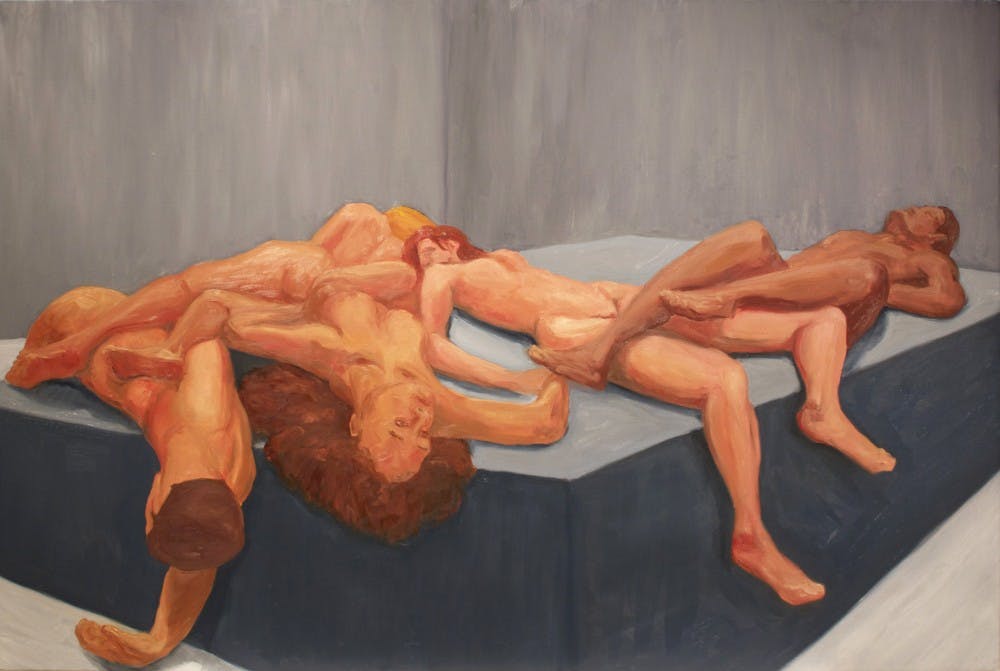Name and Year: Jesse Rappaport, 2012 Hometown: Chester, NJ Major: Fine Arts/Pre–Med Medium of Choice: Oil Paint
[photospace]
Street: Do you have any favorite artists? Role models? Jesse Rappaport: My favorite artist would probably be Jenny Saville, at least currently. I go back and forth between loving her and not, but the fact is that her paint handling and her subject matter really embodies some of the things that I respond to. Also Euan Uglow really inspires me with his unique style. One of my role models is Onelio Marrero — one of my high school art teachers — who continues to amaze me with his skill.
Street: How did you get started with oil painting? What draws you to this medium in particular? JR: Ever since high school I’ve worked with oils. My high school had very skilled art teachers and I fed off of their work, which was mostly in oils. The fluidity and visceral quality of the paint also contributes to my interest with it. I love the idea of recreating a three–dimensional scene and combining the expressions of the brush to make something altogether different but alluring.
Street: What inspired you to pursue the medical profession? JR: I have always been interested in the human body; the complexity and the rawness of it grab me. Medicine, surgery in particular, is a way to be able to directly interact with the body while also helping those around me. The combination of working directly with the complexity that is the human as well as saving lives is just too mind–blowing to pass up.
Street: What forms does your interest in the human body take in your work? JR: The figure means so much to a viewer that when you put it in a piece, it can take on new life of its own, especially if it includes a portrait. I like the idea of the figure being my primary vessel for conveying my messages, using the physical form along with the idea that it represents a person. I’d like to see my work going further with expressing the relationship between the body and our own ideas of people.
Street: You mentioned that your work references many issues of contemporary life. Can you give us details about one or a few of these particular themes? JR: Recently I’ve dealt with issues such as neglect of human life and neglect of the human body after life. While these are morbid subjects, I wouldn’t say that my work necessarily needs to be about that, but it just so happens that that’s where it has taken me currently. Neglect is an issue that, while people may not realize, is still common in daily life. My painting Two Weeks is a sort of statement about that. Bioethics is a currently a hot topic, especially here at Penn. One of these concerns is grappling with the idea that respecting the human body and mind may be difficult to do when we must also learn from it for the future.
Street: You also said that though you present certain themes, you leave room for open interpretation. How do you maintain this ambiguity aesthetically? JR: My most current work, still untitled, is the image of basically a pile of dead bodies. My personal reasoning behind it was “what if a surgeon treated his patients like an artist treats his canvases, and the mistakes, though they are ways of learning, are just left on the table?” You can’t say all of this without being too heavy handed and spelling everything out for the viewer, so instead I leave some of it open. I don’t include the surgeon or any direct medical references and the space is ambiguous. The image therefore is stripped down to human forms, seemingly lifeless, on a platform of sorts. Where the viewer takes this is up to them.
Street: Do you ever experiment with other media? JR: I love working with charcoal, especially in the planning stages. It allows me to think more about space and composition while still being messy and quick. I have also worked with clay a bit in a figure sculpture course. It is so different than painting, being in three dimensions, that at first I was completely lost. As soon as I got the hang of it I really warmed up to it. It was like painting every side of the figure at once, which is very cool.
Street: What are you working on now? JR: Having just been critiqued on my recent untitled piece, I have a million different thoughts in my head of where to take my work. I’m still trying to find a way to fuse my artistic and medical interests in the best way possible and I don’t quite think I’m there yet. I might move on to images of surgically worked on bodies, or of presenting the inter workings of the human body, or of figures presented in the actual gallery space as if in a medical school anatomy lesson, or, or… I have no clue.







